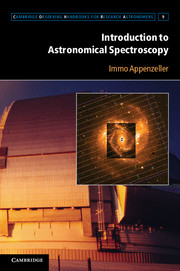Book contents
- Frontmatter
- Contents
- Preface
- 1 Historical Remarks
- 2 Spectroscopy in Present-Day Astronomy
- 3 Basic Physics of Spectral Measurements
- 4 Optical-Range Grating and Prism Spectrometers
- 5 Other Techniques for the Optical Spectral Range
- 6 Preparing and Reducing Optical Observations
- 7 UV, X-Ray, and Gamma Spectroscopy
- 8 Spectroscopy at Radio Wavelengths
- 9 Special Techniques of the FIR and Submillimeter Range
- 10 New Developments and Future Prospects
- Appendix: List of Acronyms
- References
- Index
1 - Historical Remarks
Published online by Cambridge University Press: 05 January 2013
- Frontmatter
- Contents
- Preface
- 1 Historical Remarks
- 2 Spectroscopy in Present-Day Astronomy
- 3 Basic Physics of Spectral Measurements
- 4 Optical-Range Grating and Prism Spectrometers
- 5 Other Techniques for the Optical Spectral Range
- 6 Preparing and Reducing Optical Observations
- 7 UV, X-Ray, and Gamma Spectroscopy
- 8 Spectroscopy at Radio Wavelengths
- 9 Special Techniques of the FIR and Submillimeter Range
- 10 New Developments and Future Prospects
- Appendix: List of Acronyms
- References
- Index
Summary
The purpose of this book is to provide an introduction to present-day astronomical spectroscopy. Thus, this chapter on the historical development will be restricted to a brief outline of selected milestones that provided the basis for the contemporary techniques and that are helpful for an understanding of the present terminologies and conventions. The reader interested in more details of the historic evolution of astronomical spectroscopy may find an extensive treatment of this topic in two excellent books by John Hearnshaw (1986, 2009). Additional information can be found in older standard works on astronomical spectroscopy, which were published by Hiltner (1964), Carleton (1976), and Meeks (1976). Apart from (still up-to-date) historical sections, these books provide extensive descriptions of methods that have been used in the past, before they were replaced by the more efficient contemporary techniques.
Early Pioneers
Astronomy is known for its long history. Accurate quantitative measurements of stellar positions and motions were already carried out millennia ago. On the other hand, spectroscopy is a relatively new scientific tool. It became important for astronomical research only during the past 200 years. The late discovery of spectroscopy may have been due to the scarcity of natural phenomena in which light is decomposed into its different colors. Moreover, for a long time the known natural spectral effects were not (or not correctly) understood. A prominent example is the rainbow. Reports of rainbows and thoughts about their origin are found in the oldest known written texts, and in most parts of the world almost everybody alive has seen this phenomenon.
- Type
- Chapter
- Information
- Introduction to Astronomical Spectroscopy , pp. 1 - 25Publisher: Cambridge University PressPrint publication year: 2012

